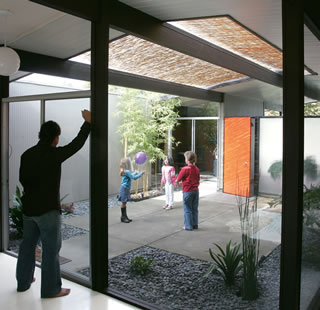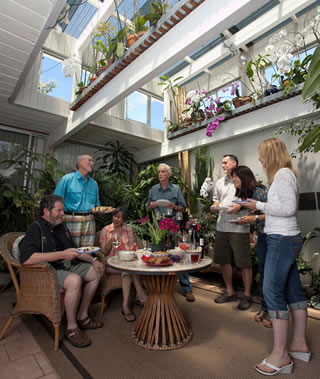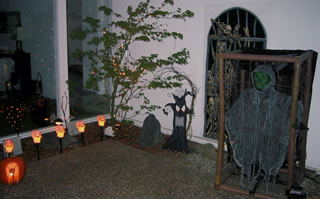Living the Atrium Life - Page 2
Turning your atrium into a dream room can be challenging—and varied, depending on your dreams.
In Conny’s case, the challenge was technological. He wanted to roof the atrium to lower energy costs. The atrium, he realized after moving into the home in 2000, acted like a chimney, venting warm air out of the house during the winter.
 |
|
|
Another reason for a roof was to protect the family’s party paraphernalia. Without a cover of some sort, imagine what a rainstorm would do to the projection TV, four speakers, and two subwoofers.
But a permanent roof wouldn’t do—they wanted the atrium to remain an outdoor space except for the times when, well, they’d prefer an indoor space.
The contractor’s proposal for a retractable roof was far from pleasing. It looked “like a tank on top of your house,” Conny says. Also displeasing was the price—a minimum of $28,000.
So Conny, an engineer who works for Oracle, did it himself, designing and building a wooden frame flashed with aluminum to prevent rot. It covers his steep-gabled atrium when needed and disappears out of sight when not. A two-inch gap at the top allows for airflow, preventing condensation; the cover overlaps the atrium so rain stays out.
“I wouldn’t say it’s an easy job that anyone could do,” Conny says. Neighbors, several of whom have tried to copy the Marx retractable roof, have suggested he go into business building them.
“They kept hoping Conny would say…” Andrea says, then her husband completes the sentence, “…I’ll build you one.”
Dining in the jungle
 |
|
|
A fixed atrium cover has turned Peter Anning and Jim Mulvaney’s Sunnyvale atrium into an orchid- and philodendron-filled ‘jungle’—one they use for casual dining and frequent social gatherings.
The atrium still retains its outdoor feeling thanks to the 95 plants growing there, including the orchids, in metal troughs atop the beams, and immense elephant ear philodendrons. “It’s an enclosed atrium—but not a closed atrium,” Anning says.
“It’s just a delightful area to hang around in, a very casual space,” Mulvaney says. “People walk in here, and they just love the space. They marvel.”
Halloween spook-a-thon
A Thousand Oaks atrium is used once a year for celebrations of quite another sort.
“We haunt our atrium every Halloween time,” says Liz Doherty, who shares the home with her daughters Edie and Lucy. Thousand Oaks has developed an increasingly lively trick-or-treating scene, and the chamber of horrors the three Doherty ladies concoct has grown notorious.
 |
 |
 |
|
|
“I know I’m successful when one kid cries,” says Liz, who under normal circumstances works as a chemist. The skill comes in handy when she drops dry ice into her atrium’s Asian-style bowl, turning it into a witch’s cauldron. Creatures hang from the ceiling, spooky music plays, and photos abound of bloodied children. “Kind of ghoulish,” she says.
But practical. “The atrium is really handy,” Doherty says, “because you can put all your stuff in there, and you don’t have to worry about it walking off.”




